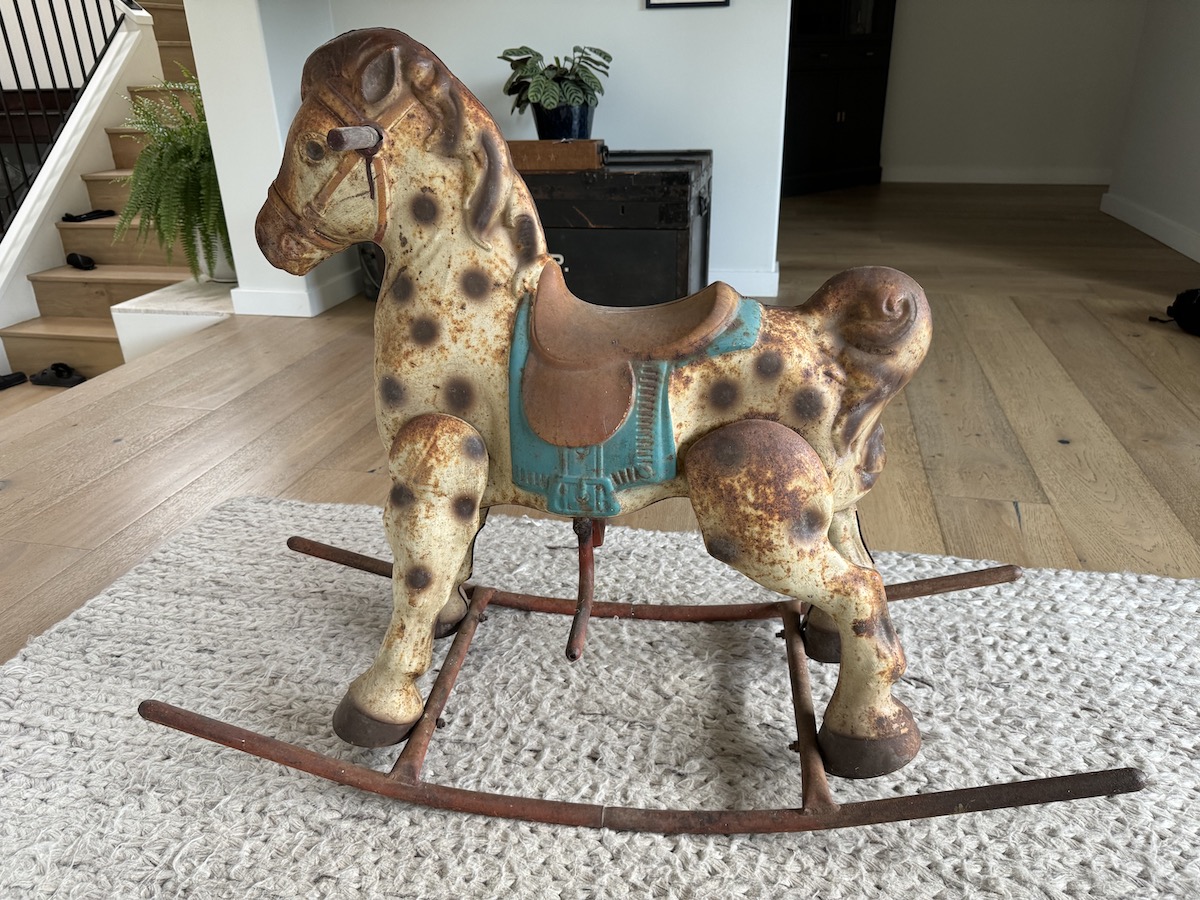Tin Rocking Horse

RH sends me a tin children’s ride-on rocking horse that has been living in his garage for years; he THINKS it belonged to his mom but he is not sure. I believe this horse was his mother’s mom’s or her dad’s, as I think this toy dates from the late 19th early 20th c.
These tin toys were stamped and shaped out of thin sheets of tin and were hazardous but adorable; I remember a flying saucer made of stamped tin owned by my brother Paul in the 1960s that he could pump to make spin. Eventually the tin seams loosened, and disaster occurred in a little sharp cut to Paul’s hand. Regulations have ramped up over the years, but when this horse was made there were NO regulations, and the market decided what toys were sold.
The horse figure has been a beloved pull-toy and rocker forever, and up till the early 1900s every child was familiar with a real live horse. My grandmother Ruth’s father had a stable of horses he used to pull his ice carts around St. Louis. Some of the first horse drawn toys were horse and wagon combinations, and the wagons were painted to advertise coal, or ice, or a fire brigade. The platform horse toys were horses upon a platform with four wheels and a rope; a child would be delighted to see the horse rising and falling as the tin body was attached to one of the axles. Germany in the late 19th c. was an innovative manufacturer of these mechanical wonders, and often attached ringing bells to the platforms. German inventors came up with a horse glider, a ride-on toy that could be coaxed by the rider to lurch back and forth: this horse was carved of wood with real leather tack and a red felt saddle blanket and cantle, a braided horsehair mane, leather ears, and embossed tin hooves. These, like all horse toys, are highly collectible and can fetch $2,000, according to the collector’s site Fabtintoys.
One of the best articulated tin hand-painted toys is a pair of golden racehorses in full stride, neck-to-neck, on a green platform. A rod is attached to each of the horses that goes through the metal platform, and is attached to an axle, which makes each horse go up and down, similar to a Carousel horse. There’s also a pair of bells in a half circular shape with metal clappers that ring as the horses are pulled – perfect for a rich little boy wearing his knickers and a cap in 1890.
Another version of the large articulated hand-painted tin horse is the late 19th c. clockwork toy horse and rider. On this toy, an inserted key would be turned to increase the tension of a wound steel spring which, as it unwound, would initiate forward movement by means of a cogged balance wheel. These can sell for thousands. George W. Brown & Company of Forestville, Connecticut was a leading maker of tinplate clockwork toys circa 1855 to 1880; one of his clockwork 8” horses sold recently for $1,700. Germany, however, lead the clockwork toy world, creating such toys as a waltzing couple, an acrobat bear, a man and a pushcart, and a clown riding a goat.
Dogs were also popular on these platform pull toys, such as a full bodied Spaniel of tin that was hand painted. A leader in the production of hand-painted tin toys, and who may have made RH’s rocking horse, was James Fallows and Sons of Philadelphia, maker of painted and stenciled tinplate toys of the late 19th c. He produced horse-drawn wagons, carts, trains, riverboats, dogs, pairs of horses on platforms, and many different mechanical systems for movement of the horse ON the platforms. He also made goats and horses together, elephants, dog sleds, combat supply trains, trollies, locomotives, and tall, tin Christmas candle supports.
Fallows began his business when he discovered he could do better than his job as a foreman at the East Coast tin toy company Francis, Field, and Francis. He founded his own business, C.B. Porter, in 1873. When his sons Henry, Charles, and David joined the business, he changed the name to Frederick and Henry Fallow Toys in 1894. The brand was stamped “IXL” meaning “I Excell,” and the Roman numerals for “61,” supposedly the date Fallows immigrated to the U.S.
The business faltered with the invention of the chromolithograph, a printing process which negated hand painting. I would estimate the value of RH’s rocking horse to be $1,200.






